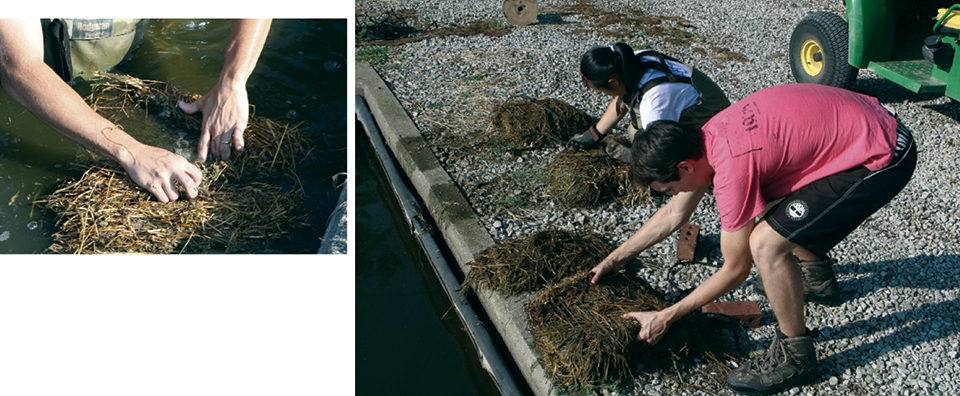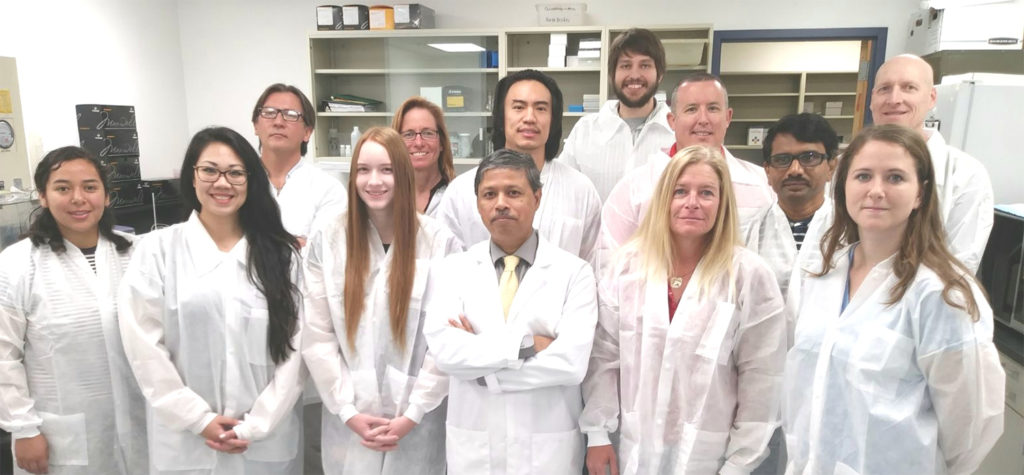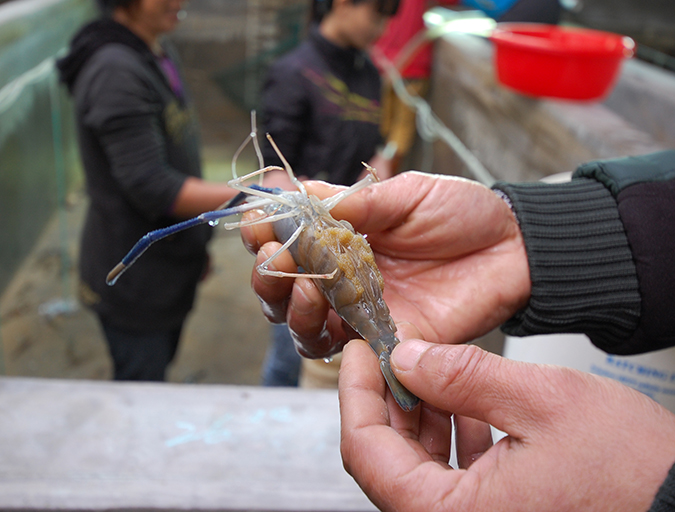Study examines alfalfa hay as forage feed supplement

The Australian red claw crayfish (Cherax quadricarinatus) is a freshwater crayfish species native to the tropical region of Queensland, Australia, and southeastern Papua New Guinea. Aquaculture of red claws is increasing because this species has numerous attributes that make it a good choice for aquaculture, including tolerance of fluctuating temperature and water quality, rapid growth and excellent yield. The non-aggressive crayfish tolerate high stocking densities if sufficient shelter is available and have a simple life cycle that supports straightforward production technology.
Red claws are very flexible in their feeding habits, consuming decaying plant and animal matter, as well as macrophytes, benthic invertebrates, algae, bacteria and fungi. This may allow expensive prepared diets to be supplemented or replaced by natural foods or forages. Combining pellet-based feeding with forage has the potential to reduce diet costs.
Earlier research conducted at Kentucky State University reported that the protein content of prepared diets for red claw crayfish can be lowered if combined with supplemented alfalfa hay. While red claws seem to use prepared diets efficiently, additional research is necessary to understand the use of feed forage combinations to reduce production costs. Another option in which costs can be reduced is to eliminate more expensive dietary components, such as vitamin and mineral premixes.
Pond study
A pond-based study by the authors compared the growth performance of red claw crayfish fed a diet moderately low (28 percent) in protein containing alfalfa hay and devoid of vitamin and mineral supplements with crayfish that received a diet containing 42 percent protein content with alfalfa hay, or red claws fed only alfalfa hay.
Juvenile crayfish were obtained from a domestic supplier and shipped without water in insulated containers with moist cool packs. Red claws with average individual weights of 15.7 ± 1.0 grams were placed into aerated pond water for acclimation. Animals that appeared healthy and active were placed into nine, 0.02-ha ponds at a rate of 640/pond or 3.2 per square meter. The ponds, which had an average water depth of 1.1 m, were located at the Aquaculture Research Center of Kentucky State University in Frankfort, Kentucky, USA.
Three replicate ponds were randomly assigned to each of the three treatments. In treatment 1, red claws were fed a complete control diet containing 42 percent crude protein and dried alfalfa hay with 14 percent protein as potential forage at a rate of 500 kg/ha/month. In treatment 2, red claws were fed a diet containing 28 percent protein without vitamin and mineral supplements but with alfalfa hay added at 500 kg/ha/month. Crayfish in treatment 3 received only dried alfalfa hay at a rate of 500 kg/ha/month.
Dietary ingredients were processed into 4-mm sinking pellets by a commercial feed mill. One-half of the total daily ration was distributed twice daily over the surface area of each pond for 105 days. Red claws in all ponds were fed 10 percent of their estimated body weights during the first two weeks, with feed volume based on body weight decreased at two-week intervals to 3 percent over the remainder of the study. The assumed weekly growth rate was 4.2 grams based upon previous published data.
Dry hay bales were placed into the ponds prior to biweekly distribution of hay over pond bottoms. Water temperature and dissolved-oxygen concentrations were measured twice daily. Total ammonia nitrogen, nitrite nitrogen and alkalinity were measured three times weekly. An electric aerator ran in the center of each pond.
Results
After 105 days, the final average weights and percentages of weight gain for red claws fed the complete diet were significantly higher (83.0 grams and 398 percent, respectively, P < 0.05) than for the crayfish fed only alfalfa hay (44.9 grams and 202 percent, respectively), but did not significantly differ (P > 0.05) from the values for red claws given the supplemental diet (76.2 grams and 367 percent, respectively – Table 1). There was no significant difference (P > 0.05) in feed-conversion ratios, which averaged 5.01, between red claws fed the control and supplemental diets.
Thompson, Mean production performance values, Table 1
| Attribute | Feed Treatment 42% Protein/ Premixes/Hay | Feed Treatment 28% Protein/Hay | Feed Treatment Hay Only |
|---|
Attribute | Feed Treatment 42% Protein/ Premixes/Hay | Feed Treatment 28% Protein/Hay | Feed Treatment Hay Only |
|---|---|---|---|
| Final weight (g) | 83.0 ± 0.1a | 76.2 ± 0.7a | 44.9 ± 4.2b |
| Weight gain (%) | 398.0 ± 2.0a | 367.0 ± 12.0a | 202.0 ± 27.0b |
| Weight gain (g/week) | 4.42 ± 0.03a | 3.99 ± 0.06a | 2.00 ± 0.27b |
| Feed-conversion ratio | 3.99 ± 0.03a | 6.18 ± 1.65a | – |
| Survival (%) | 65.1 ± 0.4a | 57.2 ± 7.4a | 30.3 ± 1.0b |
| Yield (kg/ha) | 1,708 ± 11a | 1,378 ± 179a | 431 ± 49b |
At 65.1 percent and 57.2 percent, respectively, survival did not differ significantly (P > 0.05) between the crayfish in treatments 1 and 2. However, red claws fed only alfalfa hay had survival of only 30.3 percent. Crayfish fed the control and supplemental diets had significantly higher (P < 0.05) total yields of 1,708 and 1,378 kg/ha, respectively, compared to 431 kg/ha for the red claws fed only alfalfa hay.
Thompson, Mean water quality parameters, Table 2
| Parameter | Feed Treatment 42% Protein/ Premixes/Hay | Feed Treatment 28% Protein/Hay | Feed Treatment Hay Only |
|---|
Parameter | Feed Treatment 42% Protein/ Premixes/Hay | Feed Treatment 28% Protein/Hay | Feed Treatment Hay Only |
|---|---|---|---|
| Dissolved oxygen (mg/L, morning) | 7.86 ± 0.06b | 8.02 ± 0.05ab | 8.20 ± 0.04a |
| Dissolved oxygen (mg/L, afternoon) | 9.28 ± 0.09 | 9.09 ± 0.05 | 9.04 ± 0.04 |
| Temperature (° C, morning) | 23.10 ± 0.21 | 22.80 ± 0.18 | 23.00 ± 0.17 |
| Temperature (° C, afternoon) | 25.20 ± 0.23 | 24.70 ± 0.22 | 25.00 ± 0.18 |
| Total ammonia nitrogen (mg/L) | 0.99 ± 0.03 | 0.95 ± 0.03 | 1.30 ± 0.04 |
| Nitrite (mg/L) | 0.019 ± 0 | 0.004 ± 0 | 0 ± 0 |
| Alkalinity (mg/L) | 122.0 ± 1.9 | 114.0 ± 1.0 | 108.0 ± 1.5 |
Table 2 summarizes the water quality conditions in the ponds. Dissolved-oxygen concentrations averaged 8.0 ppm for the morning and 9.1 ppm for the afternoon. There was no significant difference (P > 0.05) between morning and afternoon water temperatures, which averaged 23 and 25.0 degrees-C, respectively. There also was no significant difference in total ammonia nitrogen, nitrite nitrogen and alkalinity levels among the three treatments, which were within acceptable limits for red claw crayfish.

Discussion
Vitamin and mineral premixes typically cost $15-35/ton in the United States, although costs vary with geographic location and availability. Results of this study demonstrated that red claws grown in ponds at low density can be fed a diet containing 28 percent crude protein without vitamin and mineral premixes with no adverse effects on growth, survival, tail muscle yield and body composition.
The 6.18 feed-conversion ratio (FCR) for red claws fed the supplemental diet was lower than or similar to previous reports, but higher than values reported by others. The higher FCR values in this study were probably due to several factors. The actual survival at harvest was lower than the 70 percent estimated survival used to determine feeding rates. Secondly, the water stability of the diets (62 to 67 percent) was lower than the 88 to 95 percent stability published elsewhere.
As red claws are bottom feeders and typically slow eaters compared to finfish, the water stability of a diet is very important. However, while the percentage of diet fed should be reduced from the levels used in the present study, the 4.2 grams/week calculation of growth rate appears accurate.
The total yield of red claws fed the supplemental diet was higher than that reported in other studies. This was due to the slightly higher final individual weights and survival percentages in this study, but not density, as the stocking density used was similar to the rates found in other reports.
Perspectives
The results of the present study indicated that in ponds receiving forage input, red claw crayfish performed as well with a supplemental diet containing moderately low protein and no vitamin/mineral premixes as with a more complete diet with much greater protein and added vitamins and minerals. The use of such supplemental diets can help reduce costs and thereby increase producer profits. Further research should be conducted using lower-protein diets without vitamin and mineral premixes to determine the minimum protein level for pond-grown red claws.
(Editor’s Note: This article was originally published in the July/August 2014 print edition of the Global Aquaculture Advocate.)
Now that you've reached the end of the article ...
… please consider supporting GSA’s mission to advance responsible seafood practices through education, advocacy and third-party assurances. The Advocate aims to document the evolution of responsible seafood practices and share the expansive knowledge of our vast network of contributors.
By becoming a Global Seafood Alliance member, you’re ensuring that all of the pre-competitive work we do through member benefits, resources and events can continue. Individual membership costs just $50 a year.
Not a GSA member? Join us.
Authors
-
Kenneth R. Thompson
Kentucky State University
Aquaculture Research Center
103 Athletic Road
Frankfort, Kentucky 40601 USA -
Carl D. Webster, Ph.D.
Kentucky State University
Aquaculture Research Center
103 Athletic Road
Frankfort, Kentucky 40601 USA -
Yuka Kobayashi
Kentucky State University
Aquaculture Research Center
103 Athletic Road
Frankfort, Kentucky 40601 USA -
Vaun C. Cummins
Kentucky State University
Aquaculture Research Center
103 Athletic Road
Frankfort, Kentucky 40601 USA -
Joao Fernando Albers Koch
Kentucky State University
Aquaculture Research Center
103 Athletic Road
Frankfort, Kentucky 40601 USA
Tagged With
Related Posts

Intelligence
Omega-6s and the threat to seafood’s healthy halo
Research shows farmed fish fed diets heavy on vegetable oils have higher amounts of omega-6s and lower amounts of omega-3s, compared to fish fed diets heavy on fish oil. We take a deep dive into the relationship between the two fatty acids.

Health & Welfare
The history and future of the Aquaculture Pathology Laboratory
The University of Arizona’s Aquaculture Pathology Laboratory has significantly contributed to the expansion of the shrimp farming for three decades.

Intelligence
An inside look at Sino Agro Foods’ giant prawn MegaFarm
Sino Agro Foods has developed a proprietary recirculating aquaculture system that yields high production volumes and profitability. The facility should significantly contribute to seafood production in China and to help satisfy increasing demand for high value, safe and sustainably produced seafood.

Intelligence
An engineer’s design for a classroom aquaculture-aquaponics system
An aquaponics teaching system was designed, built and operated by students at the University of Arizona, integrating its operation and management into the educational curriculum. This engineering design will require minimum maintenance and will last years.



